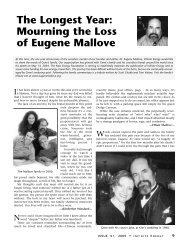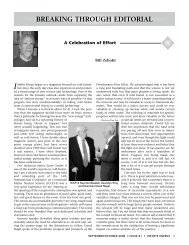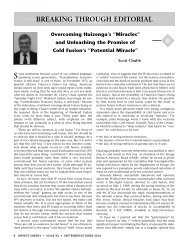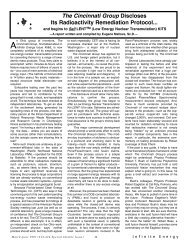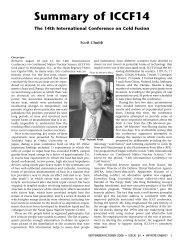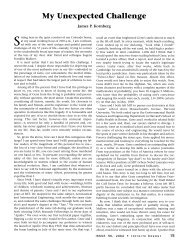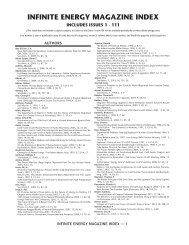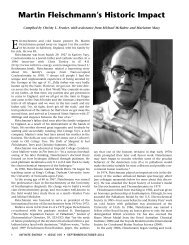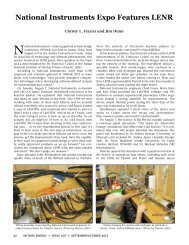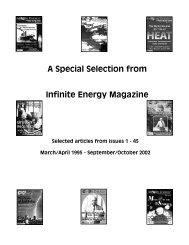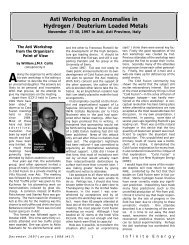MIT and Cold Fusion: A Special Report - Infinite Energy Magazine
MIT and Cold Fusion: A Special Report - Infinite Energy Magazine
MIT and Cold Fusion: A Special Report - Infinite Energy Magazine
You also want an ePaper? Increase the reach of your titles
YUMPU automatically turns print PDFs into web optimized ePapers that Google loves.
the truth or falsity of cold fusion claims, nor the issue of the way<br />
in which cold fusion has been regarded at <strong>MIT</strong> generally, but<br />
the manner in which a specific piece of scientific research was<br />
conducted by one particular group at <strong>MIT</strong>.<br />
Yet the effects on the scientific process to underst<strong>and</strong> a baffling<br />
new phenomenon cannot be ignored. The <strong>MIT</strong> work has<br />
been widely cited as a keystone in dismissing the claims of<br />
Fleischmann <strong>and</strong> Pons. It also no doubt was one factor in the<br />
decision by former Chemistry Department head, Mark S.<br />
Wrighton, to sign the DoE <strong>Energy</strong> Research <strong>and</strong> Advisory Board<br />
report (November, 1989), “<strong>Cold</strong> <strong>Fusion</strong> Research,” which most<br />
observers would agree eventually ended DoE funding of cold<br />
fusion research in the United States. Professor Wrighton was a<br />
key author of the <strong>MIT</strong> research paper.<br />
The <strong>MIT</strong> work in question has to do with calorimetry, the<br />
measurement of heat in electrochemical cells that were set up<br />
by the <strong>MIT</strong> research group to test the claims by Professors Pons<br />
<strong>and</strong> Fleischmann to have measured significant excess power in<br />
some cells. The part of the paper that is of most concern is the<br />
section on calorimetry, not the results of nuclear measurements,<br />
although I do believe that the paper’s statement in its final summary<br />
with regard to nuclear measurements is completely<br />
unfounded: “Importantly, the level of fusion products present is<br />
by far a more sensitive indicator of fusion reactions than are the<br />
relatively insensitive heat-based measurements which form the<br />
foundation of the claim of nuclear fusion as put forth by FPH.”<br />
This statement presumed that all the possible nuclear reaction<br />
paths <strong>and</strong> products that might explain cold fusion were known<br />
a priori <strong>and</strong> were measured by the <strong>MIT</strong> group, clearly a statement<br />
that an objective scientist investigating a puzzling new<br />
phenomenon should not be making. In fact, theoretical <strong>and</strong><br />
experimental developments have, I believe, totally invalidated<br />
those early beliefs by the <strong>MIT</strong> team. So the nuclear effects part<br />
of the paper, while useful <strong>and</strong> interesting, does not go to the<br />
heart of the cold fusion question as it was in 1989: Is there unexplained<br />
excess power in some electrochemical cells run in heavy<br />
water <strong>and</strong> palladium-platinum electrodes?<br />
I respectfully ask you to initiate an immediate inquiry to<br />
determine whether a thorough investigation of the specific concerns<br />
that I have enumerated below is warranted. I believe that<br />
these concerns are certainly of sufficient magnitude to justify an<br />
investigation consistent with the Policies <strong>and</strong> Procedures guide<br />
for <strong>MIT</strong> faculty <strong>and</strong> staff. Those who are co-authors of the<br />
paper, including Professor Wrighton, should, of course, disqualify<br />
themselves from participating in the inquiry <strong>and</strong> subsequent<br />
investigation. I also request that Dean of Science Professor<br />
Robert Birgeneau not be involved in any inquiry <strong>and</strong> possible<br />
subsequent investigation, due to his well known negative<br />
view of cold fusion research.<br />
The objectives of the investigation should be three-fold: (1) To<br />
determine whether there was misconduct in the h<strong>and</strong>ling <strong>and</strong><br />
representation of the data to other scientists <strong>and</strong> to the public;<br />
(2) To determine whether there was misconduct <strong>and</strong>/or sufficiently<br />
egregious errors in the work to warrant the paper’s<br />
retraction or significant amendment; <strong>and</strong> (3) To determine<br />
whether two of the paper’s authors, Professor Ronald R. Parker<br />
<strong>and</strong> Associate Professor Ronald Ballinger, engaged in unethical<br />
behavior in orchestrating a public attack on the motives of<br />
researchers whose work they hoped to prove incorrect -- in part<br />
with the forementioned research paper. Further, to determine<br />
whether Professor Parker subsequently engaged in unethical<br />
behavior in deceiving the scientific community, the <strong>MIT</strong> News<br />
Office, <strong>and</strong> former <strong>MIT</strong> President Paul Gray about the nature of<br />
his actions.<br />
Specific Concerns Enumerated<br />
The <strong>MIT</strong> Plasma <strong>Fusion</strong> Center/Chemistry Department experimental<br />
contribution to cold fusion research was conducted from late March<br />
1989, through late May 1989. The search for evidence of cold fusion in<br />
heavy water cells <strong>and</strong> comparisons with light water cells included<br />
attempts to find various nuclear products, as well as indications of<br />
excess power.<br />
One experiment in the series of experimental cells reported in this<br />
work is of particular interest, because it is the only case in which some<br />
of the graphs of the raw data that form the power measurements are<br />
shown. This so-called “Phase II” calorimeter experiment compared the<br />
power production of a light water control cell <strong>and</strong> a heavy water cell.<br />
The record of the controversy clearly shows that at that time scientists<br />
were placing great emphasis on the need to find differences in the<br />
power production between light water cells <strong>and</strong> heavy water cells.<br />
Numerous statements by a variety of scientists at the time—on both<br />
sides of the controversy—attest to this, <strong>and</strong> these statements could readily<br />
be assembled if necessary. The presumption by many at the time <strong>and</strong><br />
subsequently was that if a heavy water cell produced excess power <strong>and</strong><br />
BREAKING<br />
SYMMETRY<br />
<strong>Cold</strong> <strong>Fusion</strong> Movie<br />
Imitates Life. . .<br />
“COMING TO A THEATER<br />
NEAR YOU”<br />
Written, Produced, <strong>and</strong> Directed<br />
by former <strong>MIT</strong> Professor Keith Johnson<br />
(Dept. of Materials Science)<br />
[Excerpts from a Synopsis by Writer,<br />
Producer, <strong>and</strong> Director Keith Johnson]<br />
Carolyn, late twenties, a recent Ph.D. in Astrophysics from<br />
Cal. Tech., where she developed a theory of “cosmic dark matter,”<br />
arrives at a renowned Boston area Technical Institute to<br />
fill an Assistant Professor physics faculty position. There she<br />
meets her supervisor, Professor Klinger, a pompous physicist<br />
who heads up the <strong>Fusion</strong> <strong>Energy</strong> Lab devoted to harnessing<br />
the nuclear energy of the sun. Carolyn is told she is replacing<br />
another woman, Yvonne, who was denied tenure, <strong>and</strong> (under<br />
threat of future tenure denial) is discouraged by Klinger from<br />
continuing her own work on dark matter.<br />
While moving into her apartment, Carolyn meets Steven, a<br />
consultant chemist, <strong>and</strong> the chemistry between them begins.<br />
Steven tells Carolyn he knew Yvonne because of his academic<br />
interest in Yvonne's controversial Institute research on “cold<br />
fusion,” a cheap, environmentally safe way of generating energy<br />
from water. Steven informs Carolyn that Yvonne was<br />
denied tenure because her work on cold fusion threatened<br />
Klinger's costly “hot” fusion empire. . .<br />
. . .The film reaches an explosive conclusion at a rehearsal for<br />
Carolyn’s physics convention lecture. There we learn the<br />
shocking truths about. . .Klinger's role in suppressing cold<br />
fusion, <strong>and</strong> last but not least, the connection of the cold fusion<br />
energy to cosmic dark matter.<br />
41 <strong>Infinite</strong> <strong>Energy</strong> • ISSUE 24, 1999 • <strong>MIT</strong> <strong>Special</strong> <strong>Report</strong>



